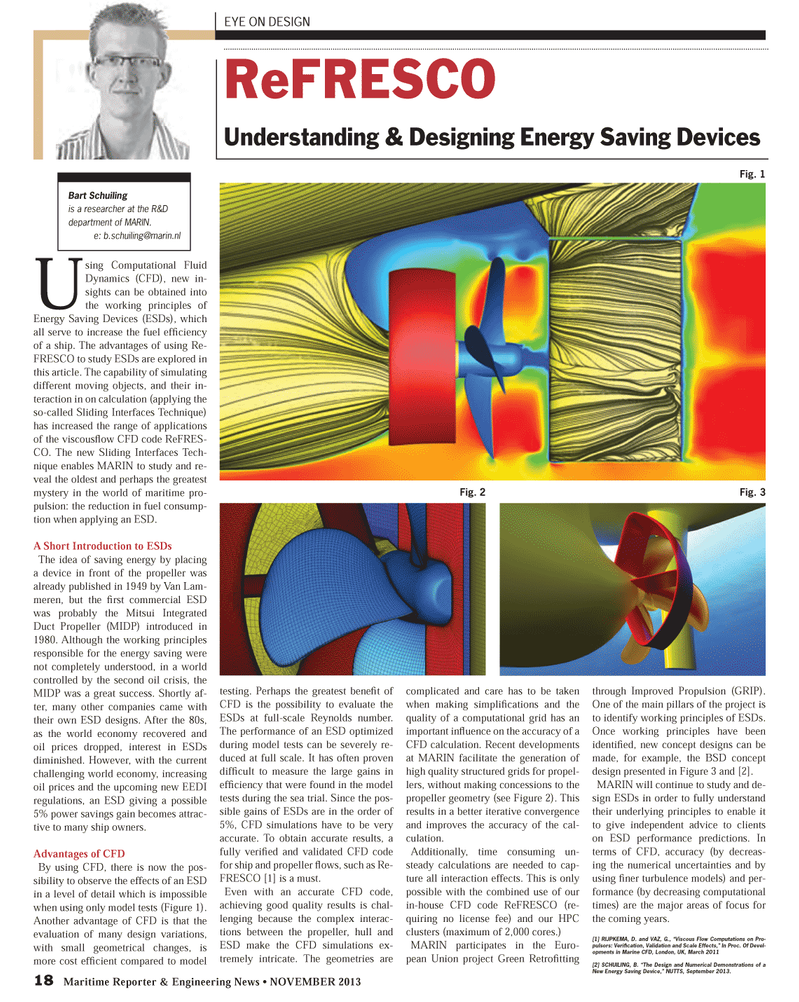
Page 18: of Maritime Reporter Magazine (November 2013)
Marine Propulsion Annual
Read this page in Pdf, Flash or Html5 edition of November 2013 Maritime Reporter Magazine
18 Maritime Reporter & Engineering News ? NOVEMBER 2013 Using Computational Fluid Dynamics (CFD), new in-sights can be obtained into the working principles of Energy Saving Devices (ESDs), which all serve to increase the fuel efÞ ciency of a ship. The advantages of using Re- FRESCO to study ESDs are explored in this article. The capability of simulating different moving objects, and their in- teraction in on calculation (applying the so-called Sliding Interfaces Technique) has increased the range of applications of the viscousß ow CFD code ReFRES-CO. The new Sliding Interfaces Tech- nique enables MARIN to study and re-veal the oldest and perhaps the greatest mystery in the world of maritime pro-pulsion: the reduction in fuel consump-tion when applying an ESD.A Short Introduction to ESDs The idea of saving energy by placing a device in front of the propeller was already published in 1949 by Van Lam- meren, but the Þ rst commercial ESD was probably the Mitsui Integrated Duct Propeller (MIDP) introduced in 1980. Although the working principles responsible for the energy saving were not completely understood, in a world controlled by the second oil crisis, the MIDP was a great success. Shortly af- ter, many other companies came with their own ESD designs. After the 80s, as the world economy recovered and oil prices dropped, interest in ESDs diminished. However, with the current challenging world economy, increasing oil prices and the upcoming new EEDI regulations, an ESD giving a possible 5% power savings gain becomes attrac-tive to many ship owners.Advantages of CFDBy using CFD, there is now the pos-sibility to observe the effects of an ESD in a level of detail which is impossible when using only model tests (Figure 1). Another advantage of CFD is that the evaluation of many design variations, with small geometrical changes, is more cost efÞ cient compared to model testing. Perhaps the greatest beneÞ t of CFD is the possibility to evaluate the ESDs at full-scale Reynolds number. The performance of an ESD optimized during model tests can be severely re-duced at full scale. It has often proven difÞ cult to measure the large gains in efÞ ciency that were found in the model tests during the sea trial. Since the pos-sible gains of ESDs are in the order of 5%, CFD simulations have to be very accurate. To obtain accurate results, a fully veriÞ ed and validated CFD code for ship and propeller ß ows, such as Re- FRESCO [1] is a must. Even with an accurate CFD code, achieving good quality results is chal-lenging because the complex interac-tions between the propeller, hull and ESD make the CFD simulations ex-tremely intricate. The geometries are complicated and care has to be taken when making simpliÞ cations and the quality of a computational grid has an important inß uence on the accuracy of a CFD calculation. Recent developments at MARIN facilitate the generation of high quality structured grids for propel-lers, without making concessions to the propeller geometry (see Figure 2). This results in a better iterative convergence and improves the accuracy of the cal-culation. Additionally, time consuming un- steady calculations are needed to cap-ture all interaction effects. This is only possible with the combined use of our in-house CFD code ReFRESCO (re-quiring no license fee) and our HPC clusters (maximum of 2,000 cores.)MARIN participates in the Euro-pean Union project Green RetroÞ tting through Improved Propulsion (GRIP). One of the main pillars of the project is to identify working principles of ESDs. Once working principles have been identiÞ ed, new concept designs can be made, for example, the BSD concept design presented in Figure 3 and [2]. MARIN will continue to study and de-sign ESDs in order to fully understand their underlying principles to enable it to give independent advice to clients on ESD performance predictions. In terms of CFD, accuracy (by decreas-ing the numerical uncertainties and by using Þ ner turbulence models) and per- formance (by decreasing computational times) are the major areas of focus for the coming years.EYE ON DESIGNReFRESCOUnderstanding & Designing Energy Saving Devices Bart Schuiling is a researcher at the R&D department of MARIN. e: [email protected]. 1Fig. 3Fig. 2[1] RIJPKEMA, D. and VAZ, G., ?Viscous Flow Computations on Pro- pulsors: Veri cation, Validation and Scale Effects,? In Proc. Of Devel- opments in Marine CFD, London, UK, March 2011 [2] SCHUILING, B. ?The Design and Numerical Demonstrations of a New Energy Saving Device,? NUTTS, September 2013. MR #11 (18-25).indd 18MR #11 (18-25).indd 1811/11/2013 11:32:04 AM11/11/2013 11:32:04 AM

 17
17

 19
19
